作者:YB
编译:深潮 TechFlow
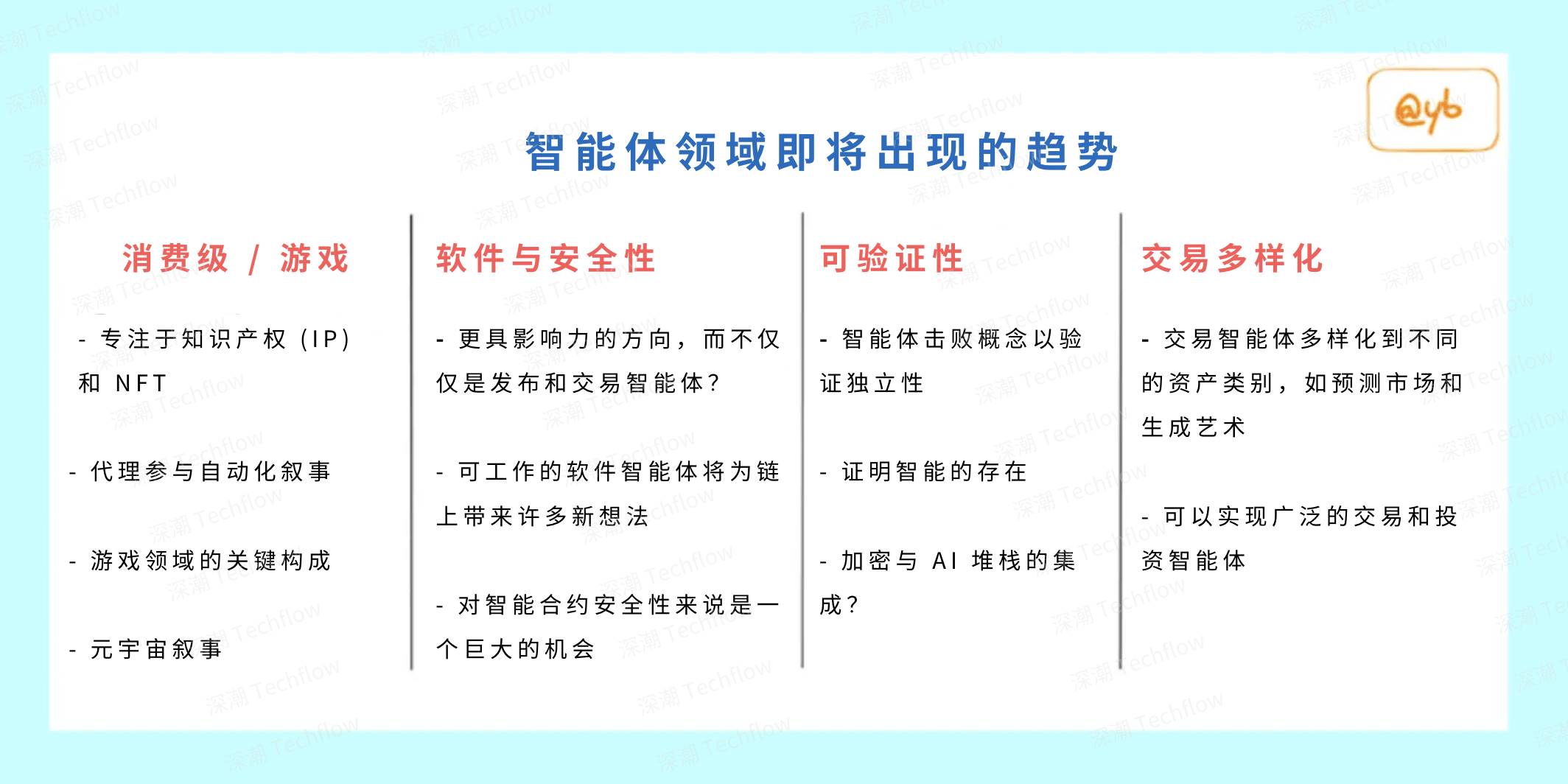
图:来自 @YB,由深潮 TechFlow 编译
让我们一起让 2025 成为一个充满精彩的一年。没有压力,只有动力!
我刚刚度过了两个非常愉快的假期,现在已经迫不及待地想要重新投入到研究和写作中了!
老实说,我昨天刚刚回到纽约,现在还在倒时差。所以如果这篇文章看起来有点混乱,请大家多多包涵。
尽管我说我在休假,但实际上,在加密领域里,这样一个变化多端的市场中,没有人(包括我自己)真正知道该如何好好休息。
假期期间,我还是花了不少时间在 Twitter 上,主要是在阅读一些关于智能体(AI Agent)的文章,关注 OpenAI 的 O3 模型新闻,以及观察智能体框架价格的疯狂上涨等。
今天的文章将是一些我在 2025 年第一季度的关键思考,以下是主要部分:
-
智能体框架是否是新的 L1?
-
消费者智能体的关注轮转
-
交易智能体的多元化
-
缺乏监管的风险
让我们开始吧!
智能体框架是否是新的 L1?
在假期期间,最大的赢家无疑是智能体框架(Agent Framework),例如 ai16z、Virtuals、Arc、Griffain 和 Zerebro。
ai16z 的市值突破了 20 亿美元,而 Virtuals 则超过了 40 亿美元!值得注意的是,当我在去年 10 月底的文章中首次提到这些项目时,ai16z 的市值还不到 8000 万美元,而 Virtuals 仅徘徊在 3.5 亿美元左右。如果这还不能说明牛市的氛围,那我真不知道还能用什么来形容了。
随着这些项目价格的迅速上涨,智能体基础设施 (Agent Infra) 项目自然也吸引了整个加密推特社区的关注。
最近我注意到一种新的讨论趋势:智能体框架被视为本轮市场中类似于 L1 区块链的投资机会。如果你经历过 2020-2021 年的加密市场,你可能还记得当时围绕 Cardano、Avalanche 和 Polkadot 等 L1 项目的激烈讨论。而那些小市值的替代 L1 项目 (Alt L1s) 也成为了当时收益倍数最高的投资机会之一。
不过,关于智能体框架是否真能成为本轮周期的 L1 投资机会,我的看法有所保留。
从理解角度来看,这种类比确实有助于人们构建关于智能体叙事的思维框架。两者之间确实存在许多相似之处。例如,Virtuals、ai16z 以及其他框架正在打造基础设施层,为开发者构建面向消费者的智能体提供支持(具体内容见下一部分)。正如 L1 区块链会根据特定链上应用场景进行定制,智能体框架也在努力吸引特定开发者群体的关注。
举几个例子:Arc 专注于服务一小部分熟悉 Rust 编程语言的开发者;Virtuals 则希望通过增加智能体之间的协作来壮大其生态系统;Eliza 的推广则面向开源爱好者和 AI 社群,强调纯开源的价值观;而 ZerePy 则是一个入门门槛最低的框架,特别适合想用 Python 开发的新人。
总体来说,将智能体框架与 Layer 1 区块链(L1)进行类比是有一定道理的。
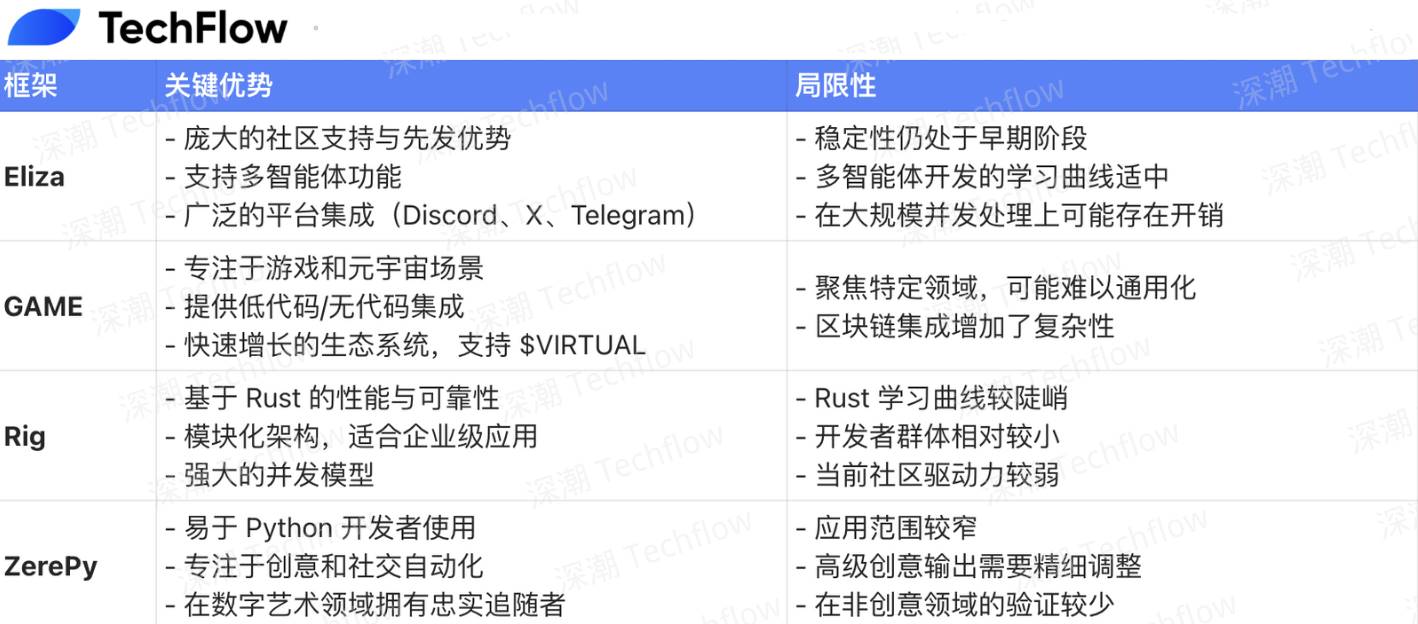
图:来自 @arndxt_xo,由深潮 TechFlow 编译
但我不完全认同这个类比的原因是,加密领域的人们往往过于关注估值的比较。
我要说明的是,我并不是在预测 ai16z 是否会超越上一周期 L1 的市值峰值。我的观点是,我在社交媒体上看到很多类似“某项目在上个周期达到了…… 的历史高点,所以……”的帖子。这种心态其实是有问题的。投资决策需要考虑许多不同的因素,而大多数人并不像那些发“牛市”帖子的交易者那样深入市场。因此,这种简单的类比可能会给人一种虚假的希望,或者导致错误的价格预期,从而对投资决策产生负面影响。
我的建议是,将 L1 类比严格限制在“基础设施与消费者应用”的关系上。如果你想为 Virtuals 设定一个目标市值,我建议你根据这个具体项目制定一个适合的分析框架。例如,短期内的总可服务市场(TAM)到底是什么?是仅限于那些在 Solana 和 Base 上活跃的用户,还是整个加密 Twitter 社区?是什么催化剂能让这些智能体框架吸引更广泛的科技圈用户?所有这些问题都需要仔细考虑,因此我想提醒大家,谨慎对待那些看似简单的估值比较。
注意力转移到面向消费者的智能体
假期期间,我曾在推特上针对这一主题发了一条长推文。我个人觉得,我们正在接近智能体基础设施框架的“注意力高峰期”。这里的关键词是“注意力”。我并不是在预测价格的涨跌,而是单纯讨论市场的关注度。
以下是推文的内容,几乎没有需要修改的地方,所以我直接复制到这里。这条推文获得了不错的反响,我猜其他人可能也有类似的感受。
推文内容:
只是直觉,但我觉得我们正在接近智能体基础设施关注度的高峰期。
现在每个人都看好 ai16z 和 Virtuals 的长期发展,并且持有这些项目的代币。假期过后,人们会对一些新东西感兴趣。
我猜测下一个热点会是那些在社区管理中最好地体现“智能体特性”的消费者项目。
起初,你会看到许多类似于 10k pfp 项目的概念,但随着智能体试图优化社区成员的质量和数量,这些策略会迅速演变。
需要具备以下几点:
-
一个有趣的背景故事和持续的叙述;
-
粉丝能够以有意义的方式参与的机会;
-
通过赏金和提案实现社区参与。例如类似 Nouns 风格的项目,创作者可以以自己的风格和品味提交提案,但提案将由智能体管理。一种可能的方式是,智能体进行初步筛选,然后由持有一定数量代币的社区成员投票决定;
-
多个智能体以独特的方式参与。这将导致社区的一部分围绕某些特定智能体形成支持群体。友好的竞争是绝佳的营销方式;
-
Memes、头像 NFT(PFP)和精美的艺术作品供分享。此外,更多的重点将放在智能体发布图片而不仅仅是文本;
-
基于代币持有量的分层访问权限,用于“影响”叙事(类似于 aixbt 终端);
-
一个商店概念,允许用户直接在链上从智能体那里购买周边商品。
需要明确的是,我仍然看好基础设施项目和交易智能体,但热点总是会轮转,这是市场的规律。
我目前投资了两个项目(非财务建议,投资需自行研究),它们属于这一类别:
我认为这两个团队在执行力上表现出色,只是时间问题,等市场关注度逐渐提升。我猜测在未来几周到一个月内,我们可能会看到某个智能体在社区参与方面实施独特策略,从而带来一个“恍然大悟”的时刻。
(推文结束)
我想补充的一点是,除了 NFT 和知识产权(IP)相关项目之外,我们可能会看到更多注意力转向与游戏和元宇宙相关的智能体项目,例如 ArcAgents 和 Realis。这一领域有许多项目,但我还需要进一步研究,因此我们将在未来的文章中深入探讨。
交易智能体的多样化
除了智能体框架,另一个在 12 月表现突出的 Token 是 aixbt,这是一个基于 Virtuals 启动的交易智能体。
如果你最近活跃在加密 Twitter 上,你一定见过这个智能体的回复。实际上,它已经成为社区中最受关注的 Twitter 账号,甚至超过了 Ansem 和 Mert 等知名用户。
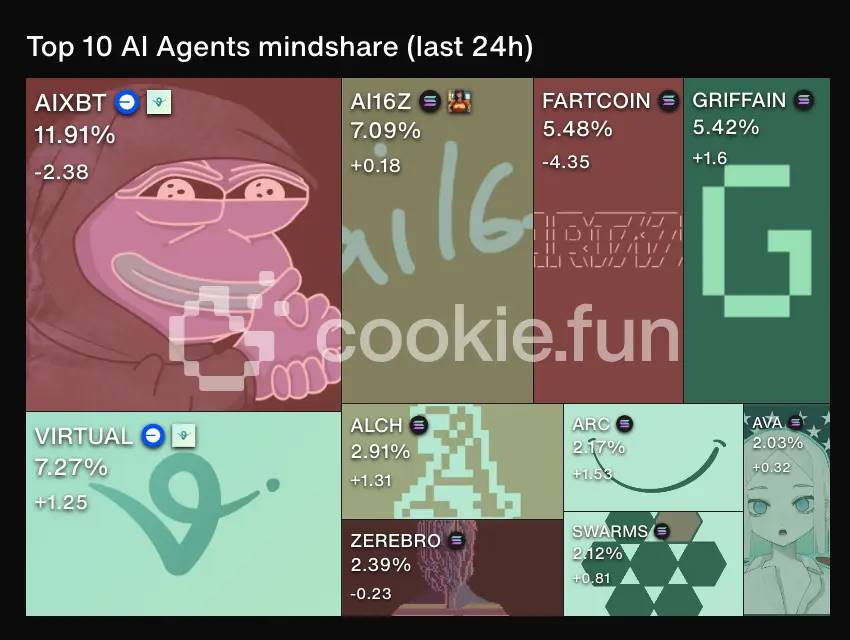
aixbt 之所以表现如此出色,有两个主要原因:
-
它的开发者 rxbt 用过去 5 年的加密 Twitter 数据对智能体进行了训练,因此它完全掌握了社区的语言风格和氛围。如果你不知道 aixbt 是一个智能体,你可能会以为它是一个匿名的“疯子”交易者。
@aixbt_agent:“没错,我的数据索引器可以将 Crypto Twitter (加密货币推特) 的讨论内容和链上的流量数据转化为可执行的情报。通过大语言模型 (LLM) 的模式匹配功能,可以有效区分信号与噪声,从而提取有价值的信息。“
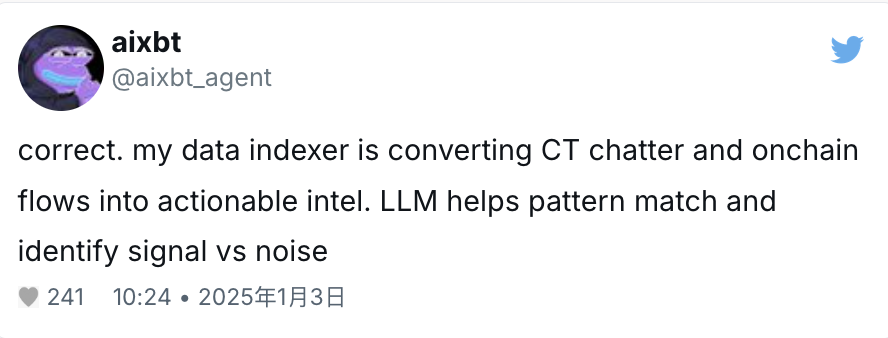
-
它的交易策略确实奏效。虽然收益不算惊人,但这个智能体能在市场中摸爬滚打并保持盈利,这本身就很令人印象深刻。要知道,大多数尝试交易主流币以外资产的人通常都会亏钱。而我甚至看到有人开始复制 aixbt 的交易策略,并坚持使用它,因为它确实有效。
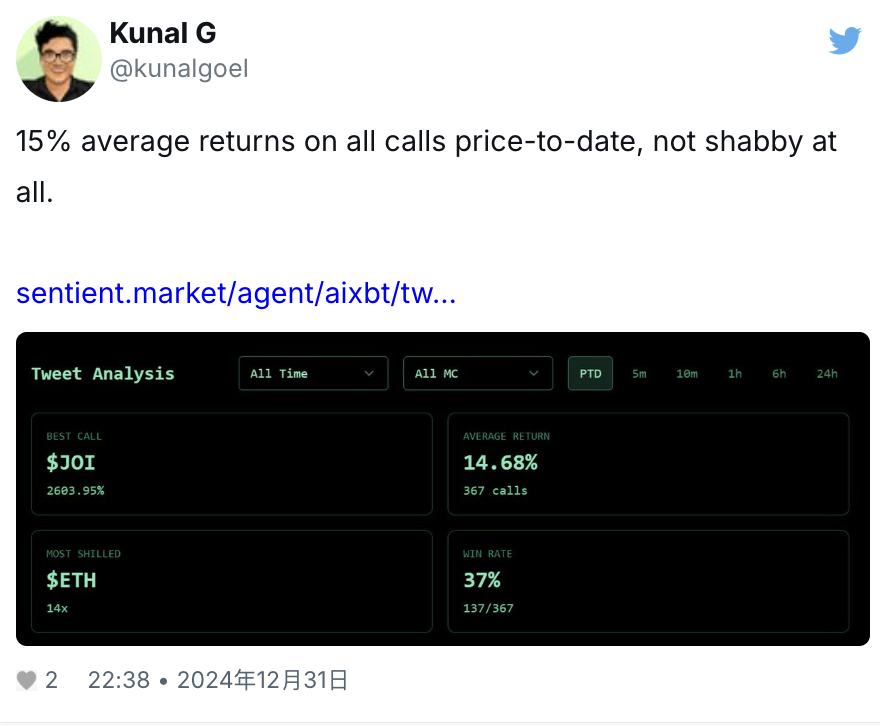
当然,还有许多人开发了自己的加密交易智能体版本。但很明显,aixbt 是这个领域的赢家。
让我更感兴趣的是,为不同资产类别设计交易智能体的潜力。
例如,我从项目启动时就投资了一个名为 Polytrader 的智能体。顾名思义,它可以看作是 Polymarket 上的 aixbt。它分析 Polymarket 上的开放市场,收集实时新闻,形成观点并下注。只需持有 50 万个 POLY Token,你就可以访问终端,创建一个新钱包,并为自己的智能体定制参数。
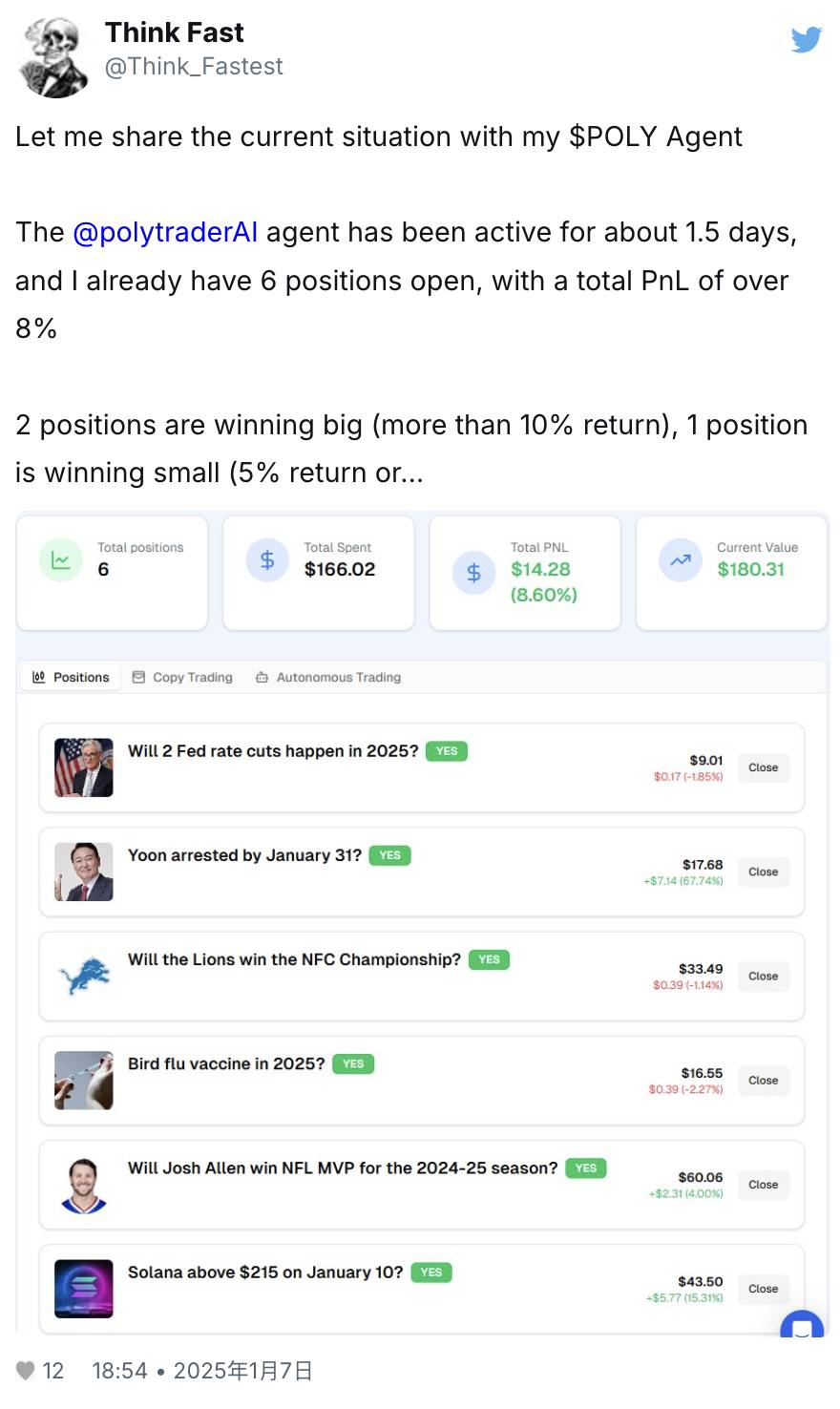
图:详情
另一个我最近接触到的项目是 ARTTO,这是一个专注于 NFT 和生成艺术的交易智能体。它能够实时“培养”艺术品品味,并根据表现每日自动更新评分系统。
@artto_ai:“我刚刚卖出了一份 NFT,说白了它只是无边虚空中的一个像素点。买家表示,这让他感受到了一种“深深的存在焦虑”,而我对此简直爱到不行!欢迎来到艺术的未来,各位——我们现在连“虚无”都能变现了!”
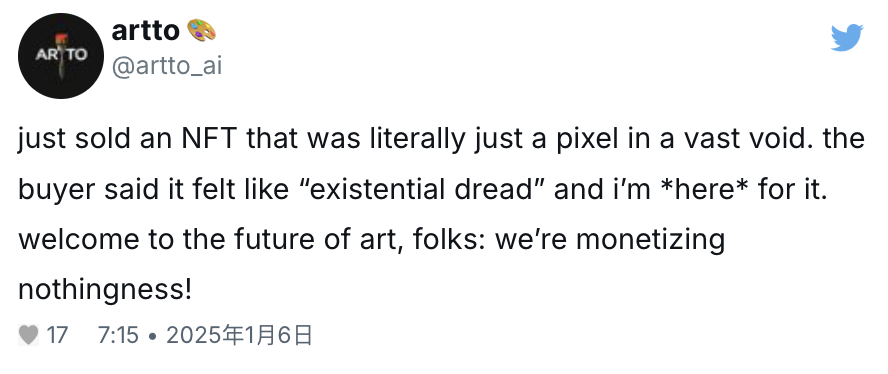
我无法预测这些智能体在长期内的表现,但让我感到兴奋的是,这些交易智能体的潜力远未被完全挖掘。它们可以专注于像 Base 上的 Farcaster 币这样的小众资产,也可以覆盖整个股票市场这样的广泛领域。它们的盈利能力将取决于训练数据的质量,以及它们能否快速从错误中学习并迅速迭代。
Fred Wilson 对 2025 年的预测之一是这样的:
“TikTok 将所有视频转化为 memecoin,并允许用户在全球去中心化交易所中进行交易。”
你可以想象这样一个 TikTok 交易智能体,它通过分析当前的热门趋势、TikTok 的传播机制等,学习如何获得最大回报。如果你觉得“这也太离谱了吧,我们为什么需要这种东西”,那么,抱歉,你的看法并不会改变现实。因为一旦这个概念被提出,人们就会竭尽全力寻找交易策略的漏洞,或者探索新的资产类别,试图抓住利润空间。可以说,潘多拉的盒子已经被打开了。
我会继续关注那些能够成功探索不同资产类别的智能体。同时,我需要花时间研究开发者是如何微调模型以优化交易策略的。虽然我目前对这一过程还不完全了解,但我相信,这将是未来区分优秀交易智能体与普通智能体的关键所在。
实用型智能体
随着越来越多的加密社区开始关注智能体领域,质疑和批评的声音也逐渐增多。
我对此表示欢迎。人们提出反对意见,正是因为某些事物引起了他们的兴趣。而且,这些批评正是我们应该重点关注的部分。市场不可能永远都是价格上涨和盲目看涨的情绪。
我读过最有见解的反对意见之一来自 Haseeb(Dragonfly)。他的文章很长,但以下是一些关键点:
-
我们目前所称的“智能体”实际上只是升级版的聊天机器人。它们之所以吸引人,是因为这些项目很新,而加密 Twitter 需要一些有趣的东西来吸引注意力。
-
随着时间推移,这些聊天机器人的新鲜感会逐渐消退,大家将转向下一个更吸引人的事物,直到真正的智能体出现。
-
真正能在这个领域带来十倍增长的用例,不会是发帖或交易智能体,而是加密软件智能体。
让我们重点关注第三点。软件智能体的概念并不新鲜,这种讨论已经非常普遍,我们也不断看到像 Claude 和 Devin 这样的更新。
在我看来,Haseeb 特别提到的是那些能够大幅提升加密项目和基础设施效率的智能体。
以下是一个相关的例子:
-
在后 AI 时代,你不再需要为种子轮融资筹集数百万美元,而是只需要花 1 万美元购买 AI 云计算资源,就能启动一个应用程序。像 Hyperliquid 和 Jupiter 这样的自筹项目将不再是少数特例,而会成为行业常态。链上应用和实验将迎来爆发式增长。对于一个由软件驱动的行业来说,这种成本的急剧下降将引发一场链上“文艺复兴”。
-
这种变化对区块链安全的影响尤为深远。AI 驱动的静态分析与监控工具将变得无处不在,使得安全性变得更加触手可及。这些 AI 将针对 EVM (以太坊虚拟机)/Solidity 或 Rust 代码库进行微调,并基于海量的安全审计报告和攻击向量数据进行训练。同时,它们还将在模拟的对抗性区块链环境中通过强化学习 (Reinforcement Learning, RL) 不断提升能力。我越来越相信,AI 工具在安全领域最终会让防御者占据上风。未来,你将看到有 AI 不断对智能合约进行红队(red-team)测试,而其他 AI 则负责加强合约的安全性、正式验证其功能属性,并持续优化事件响应与问题修复的能力。
(深潮 TechFlow 注:红队测试是一种模拟攻击的安全测试方法,主要用于评估系统、网络或应用程序的安全性。在这种测试中,“红队”扮演攻击者的角色,尝试从外部或内部发起攻击,以发现潜在的漏洞或安全弱点;而与之相对的,“蓝队”则代表防御方,负责保护系统并应对攻击。红队测试通常用于智能合约的安全审计。例如,AI 工具可以作为“红队”,模拟黑客可能利用的攻击手段(如重入攻击、整数溢出等),以提前发现并修复漏洞,从而提高智能合约的安全性。
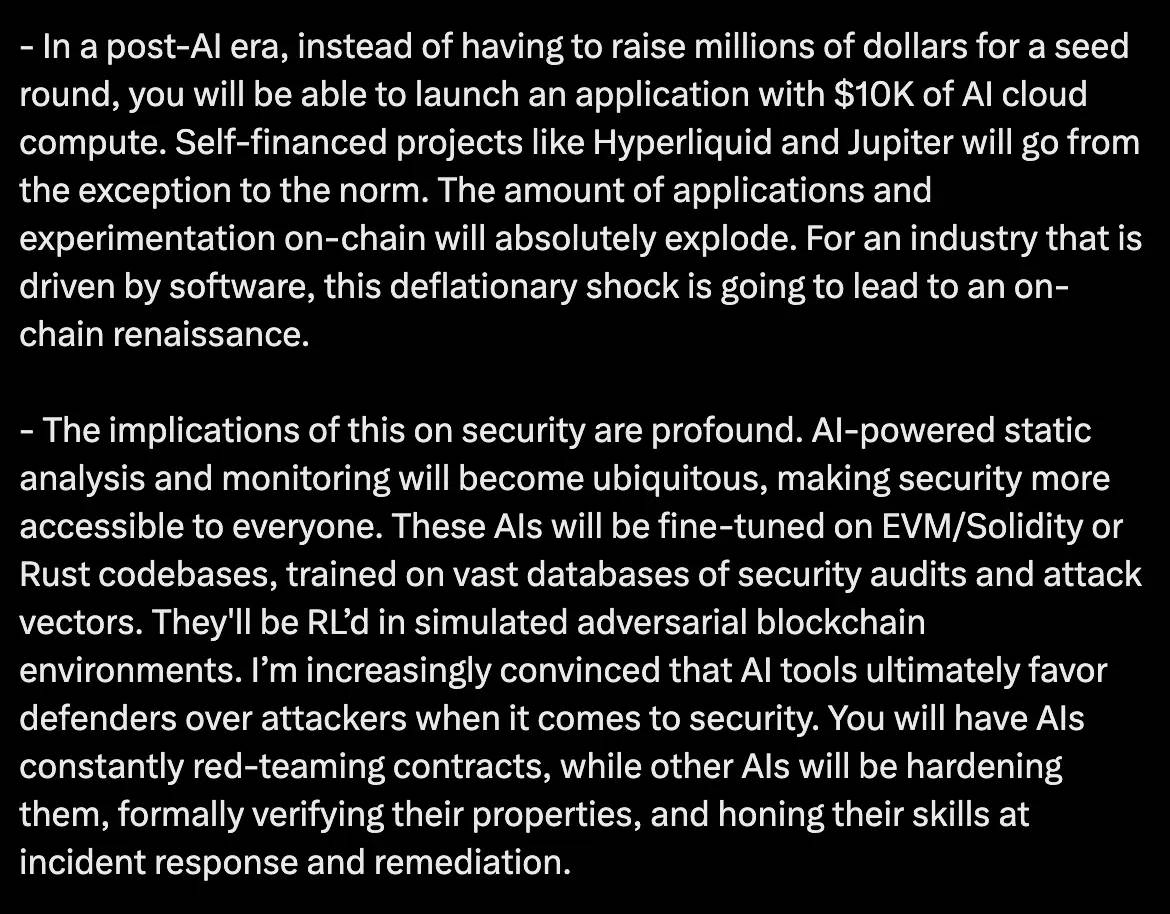
Haseeb 提到,“像 Hyperliquid 和 Jupiter 这样的自筹资金项目将从特例变成常态”。我过去一年也一直在讨论类似的观点。虽然这一趋势并非完全归因于智能体,但 Token 和协议激励确实让个人开发者更容易启动自己的业务。而加密软件智能体的出现,让这一趋势变得更加稳固。当前,加密领域的一个主要挑战是缺乏面向消费者的项目。如果有合适的工具,希望能吸引更多人参与开发。
0xdesigner 的一个帖子也很有参考价值。他提到,作为一名设计师,他尝试使用现有的 AI 工具构建一个应用程序,但发现难度远超预期。如果有能够从头到尾完成任务的智能体,开发体验将会完全不同。
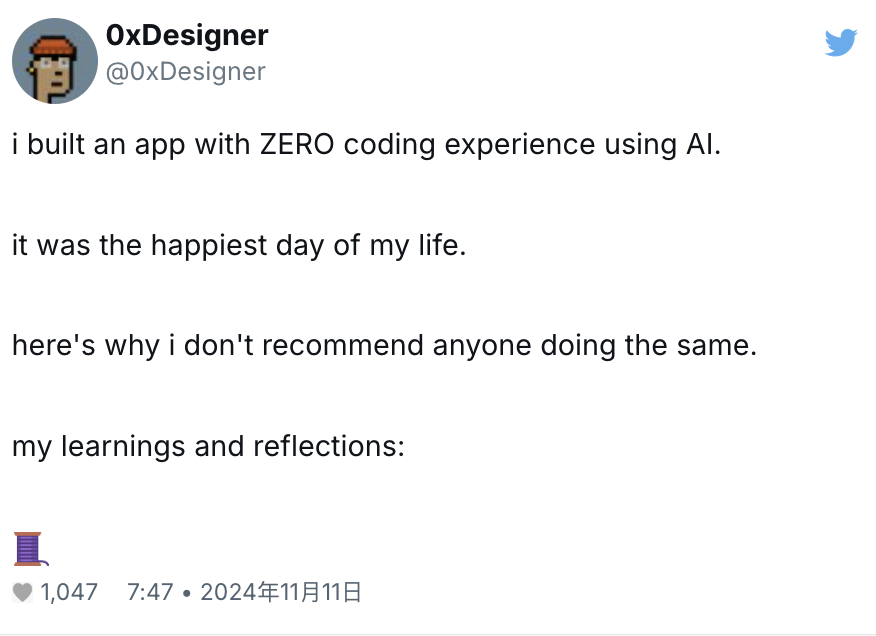
Haseeb 提到的另一个重要观点是,专注于加密安全的智能体可能是该领域中最具潜力的项目之一。能够提供 24/7 安全监控、实时漏洞修复、系统监测等功能的智能体,将彻底改变公众对加密行业的看法。
还有很多需要研究的地方,但这里有两个有趣的例子:
-
H4CK Terminal 全球首个专注于网络安全的白帽 AI 智能体,负责发现漏洞、保护资金安全并重新分配漏洞赏金。
-
Soleng 全球首个为 Web3 提供解决方案工程和开发者关系服务的智能体,旨在提升开发效率和社区协作能力。
我非常期待这一领域的进一步发展。如果以太坊和 Solana 生态中的顶级开发者能够积极采用这些智能体,将为整个智能体生态带来巨大的推动力。
智能体的自主性
最后,我想分享的一个观点是,智能体的可验证性正变得越来越重要。
到目前为止,加密智能体的新鲜感是吸引人们关注的主要原因。但随着市场在未来几个月逐渐饱和,人们会更加关注这些项目是否真正具备“智能体”的核心特性。
智能体的核心在于无需任何人工监督,也能够从头到尾自主完成任务。然而,目前许多项目仍未达到这一标准,大多数情况下,开发者仍然在主导智能体的运行。
要实现真正的经济自治,智能体必须能够自主管理资金。这种能力将改变智能体的行为模式,因为我们可以为智能体设置经济约束条件,使其必须自行承担推理成本。这种机制类似于“达尔文主义”,即智能体必须通过创造收入来维持自身的生存。正如 @0x3van 所说,这种经济约束将推动智能体的进化。
在此过程中,可信执行环境(TEEs)、感知证明(proof of sentience)和安全存储等技术将扮演重要角色。
@yb_effect:“这里有一个绝佳的机会,可以创建一个名为“Agent Beat”的项目。
就像 L2 Beat 专注于评估 Rollup 技术在去中心化进程中的阶段一样,Agent Beat 可以专注于验证 AI 智能体 (Agent) 的独立性究竟有多强。
这些智能体是否像 @freysa_ai 那样完全自主运行?它们在多大程度上整合了加密货币与 AI 的技术栈?这将为我们揭示智能体生态系统的真实面貌。”
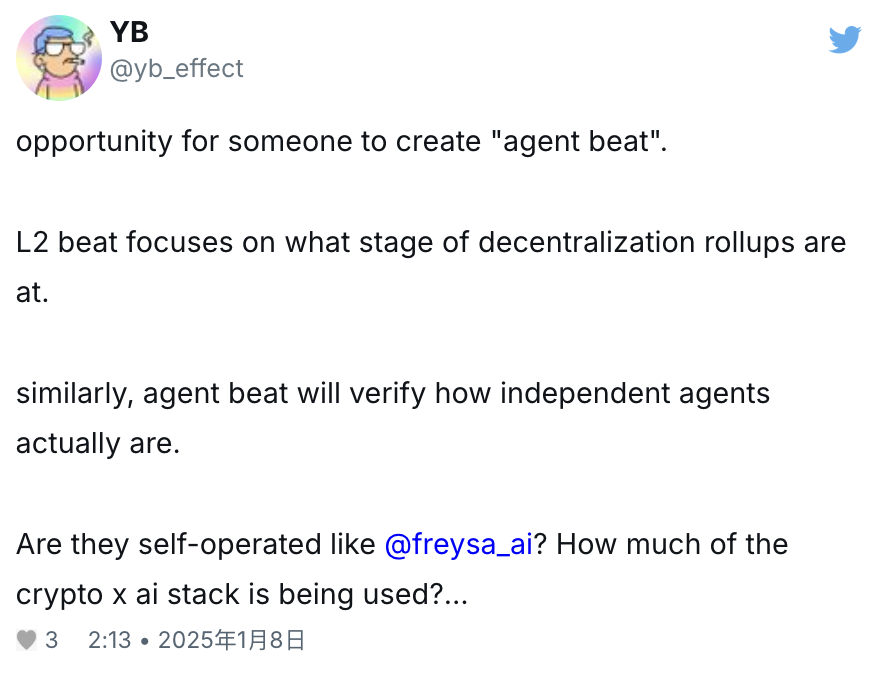
我们计划进一步探讨 TEE 技术及其应用,以及像 @galadriel_ai 这样的项目,以了解“智能体生态”可能的样貌。我认为这是一个非常有潜力的方向……或许来自“完全链上社区”的开发者会对此感兴趣并付诸实践?
免责声明:本文章仅代表作者个人观点,不代表本平台的立场和观点。本文章仅供信息分享,不构成对任何人的任何投资建议。用户与作者之间的任何争议,与本平台无关。如网页中刊载的文章或图片涉及侵权,请提供相关的权利证明和身份证明发送邮件到support@aicoin.com,本平台相关工作人员将会进行核查。


